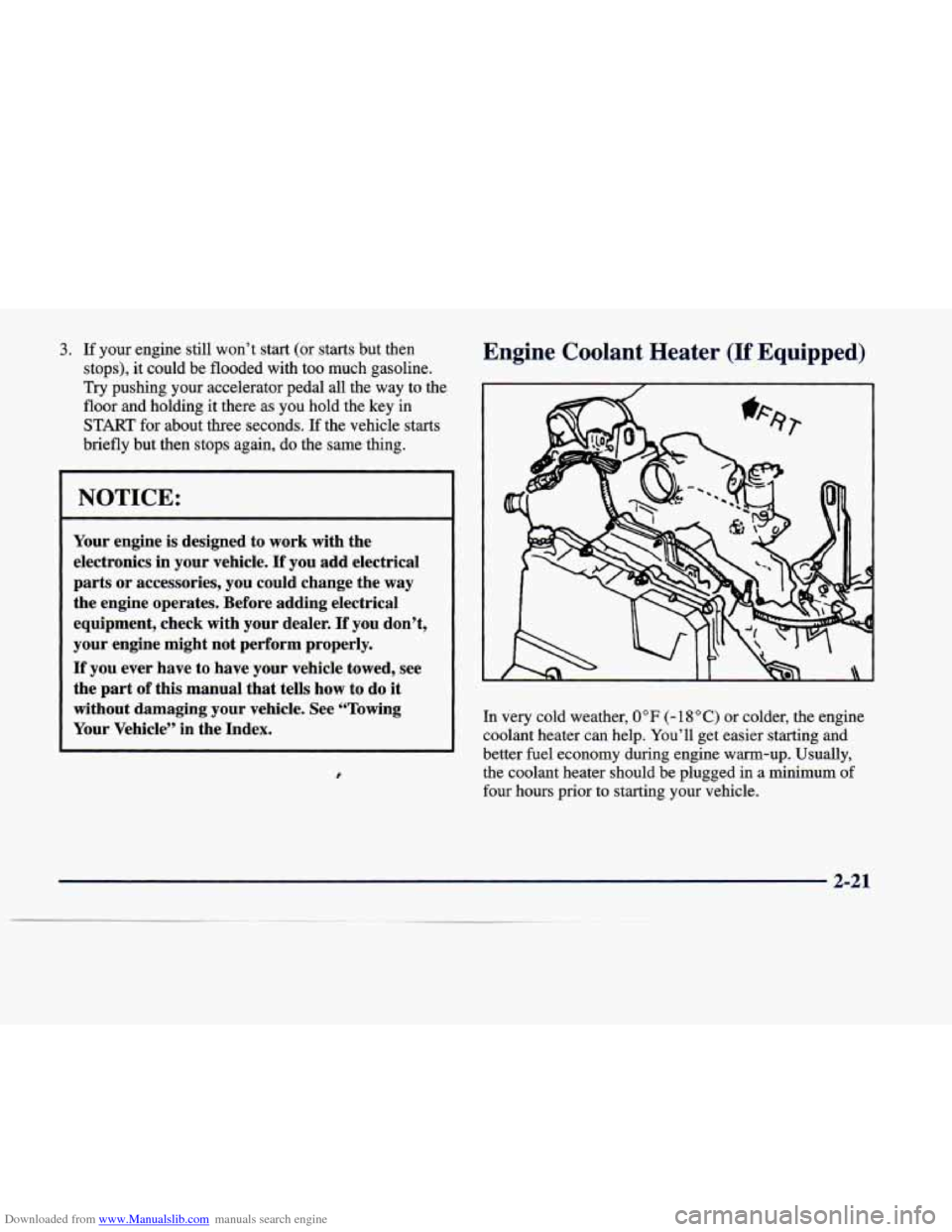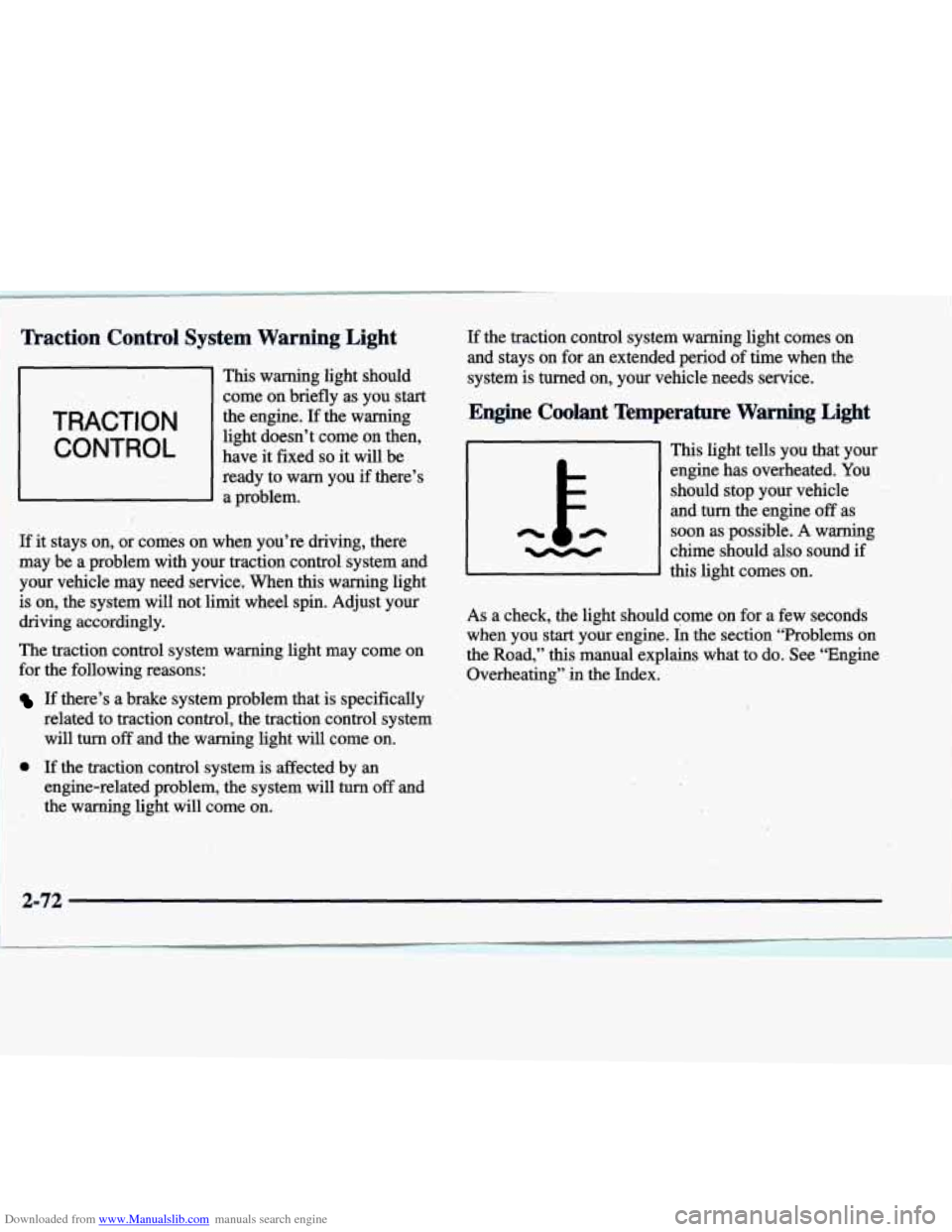1998 CADILLAC DEVILLE engine coolant
[x] Cancel search: engine coolantPage 14 of 386

Downloaded from www.Manualslib.com manuals search engine Vehicle Symbols
These are some of the symbols you may find on your vehicle.
For example,
these symbols
are used on
an
original battery:
POSSIBLE A
CAUTION
INJURY
PROTECT EYES BY
SHIELDING
CAUSTIC
ACID COULD BATTERY
CAUSE
BURNS
AVOID
SPARKS
OR
FLAMES
, SPARK OR ,\I/,
COULD FLAME
EXPLODE
~ BAllERY
These symbols
are important
for you and
your passengers
whenever your
vehicle
is
driven:
rl DOOR LOCK
UNLOCK
POWER
WINDOW
These symbols
have to do with
your lamps:
FOG LAMPS $0
These symbols
are on some
of
your controls:
WINDSHIELD
WIPER
WINDSHIELD DEFROSTER
WINDOW
DEFOGGER
These symbols are used
on
warning and
indicator lights:
COOLANT
TEMP
-
CHARGING I-1
BATTERY
SYSTEM
BRAKE
(0)
ENGINE OIL e,
PRESSURE
ANTI-LOCK
(@)
BRAKES
Here are some other symbols
you may see:
FUSE
LIGHTER
m
HORN )tT
SPEAKER
b
FUEL p3
xiii
Page 72 of 386

Downloaded from www.Manualslib.com manuals search engine Features and Controls
Here you can learn about the many standard and optional features on your ve\
hicle, and information on starting,
shifting
and braking. Also explained are the instrument panel and the warning systems that tell you if everything is
working properly
-- and what to do if you have a problem.
2-2
2-4
2-7
2- 10
2- 14 2-15
2-17
2- 18
2-18
2-20
2-2
1
2-23
2-26
2-28
2-3
1
2-3 1 Keys
Door Locks
Remote Keyless Entry (RKE) System
Trunk
Theft Theft-Deterrent System (If Equipped)
PASS-Key’II
New Vehicle “Break-In’’
Ignition Positions
Starting Your Engine
Engine Coolant Heater (If Equipped)
Automatic Transaxle Operation
Parking Brake Shifting Into PARK
(P)
Shifting Out of PARK (P)
Parking Over Things That Burn 2-32
2-32
2-33
2-34
2-35 2-42
2-46
2-48
2-54
2-56
2-56
2-5 8
2-59
2-62
2-67
2-79 Engine Exhaust
Running Your Engine While You’re Parked
Windows
Tilt Wheel
Turn SignaUMultifunction Lever
Exterior Lamps
Interior Lamps
Mirrors
Storage Compartments
Sun Visors
Cellular Telephone (Option)
Astroroof (Option)
Universal Transmitter (Option)
Instrument Panel
Warning Lights, Gages and Indicators Driver Information Center (DIC)
Page 92 of 386

Downloaded from www.Manualslib.com manuals search engine 3. If your engine still won’t start (or starts but then
stops), it could be flooded with too much gasoline.
Try pushing your accelerator pedal all the way to the
floor and holding it there as you hold the key in
START for about three seconds. If the vehicle starts
briefly but then stops again,
do the same thing.
I NOTICE:
Your engine is designed to work with the
electronics in your vehicle.
If you add electrical
parts or accessories, you could change the
way
the engine operates. Before adding electrical
equipment, check with your dealer.
If you don’t,
your engine might not perform properly.
If you ever have to have your vehicle towed, see
the part of this manual that tells how to do
it
without damaging your vehicle. See “Towing
Your Vehicle’’ in the Index.
P
Engine Coolant Heater (If Equipped)
In very cold weather, 0” F (- 18 O C) or colder, the engine
coolant heater can help. You’ll get easier starting and
better fuel economy during engine warm-up. Usually,
the coolant heater should be plugged
in a minimum of
four hours prior to starting your vehicle.
2-21
Page 93 of 386

Downloaded from www.Manualslib.com manuals search engine To Use the Engine Coolant Heater
1. Turn off the engine.
2. Open the hood and unwrap the electrical cord.
3. Plug it into a normal, grounded 110-volt AC outlet.
-
Plugging the cord into an ungrounded outlet
could cause an electrical shock. Also, the wrong
kind
of extension cord could overheat and cause
a fire. You could be seriously injured. Plug the
cord into
a properly grounded three-prong
110-volt
AC outlet. If the cord won’t reach, use a
heavy-duty three-prong extension cord rated for
at least 15 amps.
4. Before starting the engine, be sure to unplug and store
the cord as it was before to keep it away from moving
engine parts.
If you don’t, it could be damaged.
How long should you keep the coolant heater plugged
in? The answer depends on the outside temperature, the
kind of oil you have,
and some other things. Instead of
trying to list everything here, we ask that you contact
your dealer in the area where you’ll be parking
your
vehicle. The dealer can give you the best advice for that
particular area.
2-22
Page 143 of 386

Downloaded from www.Manualslib.com manuals search engine Traction Control System Warning Light
This warning light should
come on briefly as you start
the engine.
If the warning
light doesn’t come on then,
ready to warn you if there’s TRACT^ 0 N
CONTROL have it fixed so it will be
I’ a problem.
i If it stays on, or comes on when you’re driving, there
i may be a problem with your traction control system and
your vehicle may need service. When this warning light is on, the system will not
limit wheel spin. Adjust your
driving accordingly.
The traction control system warning light may come on
for the following reasons:
1 If there’s a brake system problem that is specifically
related to traction control, the traction control system
will
turn off and the warning light will come on.
I 1 0 ‘If the traction control system is affected by an
engine-related problem, the system will turn
off and
the warning light will come on.
If the traction control system warning light comes on
and
stays on for an extended period of time when the
system
is turned on, your vehicle needs service.
Engine Coolant Temperature Warning Light
This light tells you that your
engine has overheated. You
should stop your vehicle
’ ‘3
and.turn the engine off as
soon as’possible.
A warning
chime should
also sound if
this light comes on.
As a check,
the light should come on for a few seconds
when you start your engine.
Ih the section “Problems on
the Road,” this manual explains what to do. See “Engine
Overheating”
in the Index.
Page 144 of 386

Downloaded from www.Manualslib.com manuals search engine Engine Coolant Temperature Gage
Analog Cluster
This gage shows the
engine coolant
temperature. If the gage
pointer moves into the red area, the engine is too hot.
That reading means the same thing as the warning
light
-- the engine coolant
has overheated.
In the
section “Problems on the
Road,” this manual
explains what to do. See
“Engine Overheating” in
the Index.
Malfunction Indicator Lamp
(Service Engine Soon Light)
Your vehicle is equipped
with a computer which
monitors operation
of the
fuel, ignition and emission
control systems. SERVICE
ENGINE
SOON
This system is called OBD II (On-Board
Diagnostics-Second Generation) and is intended to
assure that emissions are at acceptable levels for the life
of the vehicle, helping to produce a cleaner
environment. The
SERVICE ENGINE SOON light
comes on and a chime will sound to indicate that there is
a problem and service is required. Malfunctions often
will be indicated by the system before
any problem is
apparent. This may prevent more serious damage
to
your vehicle. This system is also designed to assist your
service technician in correctly diagnosing
any
malfunction.
2-73
Page 150 of 386

Downloaded from www.Manualslib.com manuals search engine Driver Information Center (DIC)
This display gives you the status of many of your
vehicle’s systems. The DIC is also used to display driver
personalization features and warningktatus messages.
Digital Control Buttons (DeVille and
DeVille d’Elegance Only)
DISPLAY ON/OFF: Pressing this button will turn off
the Driver Information Center (DIC), Electronic Climate
Control (ECC), fuel data center, the fuel gage, trip
odometer and odometer. While the displays are off,
pressing the INFORMATION button will only turn on
the DIC. If the TRIP button is pressed or the fuel level
falls below
4 gallons (15.2 L), all of the displays will
come back on.
ENGMET: You can change the display from English
(miles) to metric (kilometers) by pressing this button.
The same button also changes other readings (like
temperature, fuel and odometer).
TRIP: By using this button, you can tell how far you’ve
gone since you last set the TRIP back to zero. To reset,
press and hold the button until zeros appear. If your
vehicle is domestic, the trip odometer will return to zero
after 999.9 miles
(1 609 km). If your vehicle is
Canadian, the trip odometer will return
to zero after 1
999.9 km (1,242 miles).
INFORMATION: Pressing this button repeatedly will
display the MPG AVG,
GAL FUEL USED, AVG MPH,
ENGINE RPM, BATTERY VOLTS, COOLANT TEMP
and OIL LIFE LEFT.
Page 155 of 386

Downloaded from www.Manualslib.com manuals search engine serviced by a technician as soon as possible. If the brake
warning light is on, follow the directions in that part.
CHECK COOLANT LEVEL - 2: This message
will appear when there is a low level of engine coolant.
Have the cooling system serviced by a technician as
soon as possible.
CHECK FUEL GAUGE - 39: This message will
appear when the
fuel supply is less than 4 gallons
(15.2 L) and the display is turned off (digital clusters
only).
A single chime will also sound when this message
is displayed.
CHECK GAS CAP - 61: This message will appear if
the gas cap has not been fully tightened.
You should
recheck your gas cap to ensure that it’s fully tightened.
CHECK OIL LEVEL - 36: For correct operation of
the low oil sensing system, your vehicle should be on a
level surface. A false
CHECK OIL LEVEL message
may appear if the vehicle is parked on grades. The oil
level sensing system does not check for actual oil level
if the engine has been off for a short period of time, and
the oil level is never sensed while the engine is running.
If the
CHECK OIL LEVEL message appears, and your
vehicle has been parked on level ground with the engine
off for at least 30 minutes, the oil level should be
checked by observing the oil dipstick. Prior to checking
the oil level, be sure the engine has been
off for five minutes and your vehicle is on a level surface. Then
check the dipstick and add oil if necessary. See “Engine
Oil’’
in the Index.
CHECK WASHER FLUID - 25: This message will
appear for several seconds indicating that
you need
washer solvent.
CRUISE ENGAGED - 43: This message will
appear for a few seconds when you select a speed at
which to cruise.
DOOR A JAR - 141: A door other than the driver’s
door is open or ajar when this message appears. The
vehicle’s engine must be running and the transaxle not
in PARK (P) for this message to display. A chime will
also sound when the vehicle’s speed
is greater than
5 mph (8 km/h).
DRIVER DOOR A JAR - 140: This message will
display when the vehicle is being shifted out of
PARK (P) with the engine running to signal that the
driver’s door is open or ajar.
A chime will also sound
when the vehicle’s speed is greater than
5 mph (8 km/h).
ENGINE COOLANT HOT, IDLE ENGINE - 44:
This message will appear when the engine coolant
temperature is over
248 “F (1 26 O C). To avoid added
strain on a hot engine, turn off the climate control
system. Stop and allow your vehicle to idle until it cools
2-84